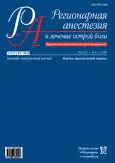Сравнительная оценка использования однократной и продленной блокады плечевого сплетения при артроскопических операциях на плечевом суставе
- Авторы: Крылов С.В.1,2, Пасечник И.Н.2, Сотников А.В.1, Тимченко Д.О.1
-
Учреждения:
- ФГБУ «Национальный медицинский исследовательский центр травматологии и ортопедии имени Н. Н. Приорова» Минздрава России
- ФГБУ ДПО «Центральная государственная медицинская академия» УД Президента РФ
- Выпуск: Том 12, № 4 (2018)
- Страницы: 211-216
- Раздел: Оригинальные статьи
- URL: https://journal-vniispk.ru/1993-6508/article/view/61287
- DOI: https://doi.org/10.17816/1993-6508-2018-12-4-211-216
- ID: 61287
Цитировать
Полный текст
Аннотация
В последнее десятилетие наблюдается неуклонный рост числа артроскопических операций на плечевом суставе. Развитие и внедрение артроскопии позволило повысить качество оказания хирургической помощи при повреждениях плечевого сустава. Однако, несмотря на малоинвазивность методики, вопросы послеоперационного обезболивания при этом типе оперативных вмешательств в полной мере не разработаны. В статье обсуждаются возможности использования однократной и продленной проводниковой анестезии у пациентов при артроскопических операциях на плечевом суставе.
Ключевые слова
Полный текст
Открыть статью на сайте журналаОб авторах
Сергей Валерьевич Крылов
ФГБУ «Национальный медицинский исследовательский центр травматологии и ортопедии имени Н. Н. Приорова» Минздрава России; ФГБУ ДПО «Центральная государственная медицинская академия» УД Президента РФ
Автор, ответственный за переписку.
Email: doc087@inbox.ru
ассистент кафедры анестезиологии и реаниматологии,врач анестезиолог-реаниматолог отделения анестезиологии и реанимации
Россия, МоскваИ. Н. Пасечник
ФГБУ ДПО «Центральная государственная медицинская академия» УД Президента РФ
Email: doc087@inbox.ru
Россия, Москва
А. В. Сотников
ФГБУ «Национальный медицинский исследовательский центр травматологии и ортопедии имени Н. Н. Приорова» Минздрава России
Email: doc087@inbox.ru
Россия, Москва
Д. О. Тимченко
ФГБУ «Национальный медицинский исследовательский центр травматологии и ортопедии имени Н. Н. Приорова» Минздрава России
Email: doc087@inbox.ru
Россия, Москва
Список литературы
- Акимкина А.М., Знаменский И.А., Гончаров Е.Н., Чибисов С.М., Лисаченко И.В., Юматова Е.А. Возможности магнитно-резонансной томографии в диагностике повреждений плечевого сустава при острой травме. Радиология. 2010; 2: 7–16.
- Карасев Е. А., Карасев Т. Ю. Артроскопическая стабилизация плечевого сустава при привычном вывихе плеча. Гений ортопедии. 2014; 1: 5–8.
- Сухин Ю. В., Логай В. А. Разработка компьютерно-навигационной системы для лечения привычного вывиха плеча. Учен. записки Петрозаводского гос. ун-та. 2015; 147 (2): 8–35.
- Hughes M. S., Matava M. J., Wright R. W., Brophy R. H., Smith M. V. Interscalene brachial plexus block for arthroscopic shoulder surgery: a systematic review. J. Bone Joint Surg. Am. 2013; 95 (14): 18–24.
- Iyengar J. J., Samagh S. P., Schairer W., Singh G., Valone F. H. 3rd, Feeley B. T. Current trends in rotator cuff repair: surgical technique, setting, and cost. Arthroscopy. 2014; 30 (3): 284–8.
- Овечкин А.М. Хронический послеоперационный болевой синдром – подводный камень современной хирургии. Регионарная анестезия и лечение острой боли. 2016; 10 (1): 5–18.
- Beecroft С.L., Coventry D.M. Anaesthesia for shoulder surgery. Contin. Educ. Anaesth. Crit. Care Pain. 2008; 8 (6): 193–8.
- Lee H.-Y., Kim S. H., So K. Y., Kim D. J. Effects of interscalene brachial plexus block to intra-operative hemodynamics and postoperative pain for arthroscopic shoulder surgery. Korean J. Anesthesiol. 2012; 62 (1): 4-30.
- Karels C.H., Bierma-Zeinstra S.M., Verhagen A.P., Koes B.W., Burdorf A. Sickness absence in patients with arm, neck and shoulder complaints presenting in physical therapy practice: 6 months follow-up. Man. Ther. 2010; 15 (5): 476–481.
- Verelst P. Respiratory impact of analgesic strategies for shoulder surgery. Reg Anesth Pain Med. 2013; 38: 50-53.
- Fredrickson M.J. Neurological complication analysis of 1000 ultrasound-guided peripheral nerve blocks for elective orthopaedic surgery: a prospective study. Anaesthesia. 2009; 64: 836–44.
- Gelfand H.J. Analgesic efficacy of ultrasound-guided regional anesthesia: a meta-analysis. J. Clin. Anesth. 2011; 2: 90–6.
- Salviz E.A., Xu D., Frulla A., Kwofie K., Shastri U., Chen J. et al. Continuous interscalene block in patients having outpatient rotator cuff repair surgery: a prospective randomized trial. Anesth. Analg. 2013; 117 (6): 85–92.
- Levin, P. The opioid epidemic. J Am Acad Orthop Surg. 2015; 23: 36–7.
- Пасечник И.Н. Программа Fast Track в хирургии: роль послеоперационного обезболивания. Анестезиология и реаниматология. 2015; 15: 49–53.
- Nadeau M-J. Ultrasound-guided regional anesthesia for upper limb. J Can Anesth. 2013; 60: 304–20.
- Duggan E. Minimum effective volume of local anesthetic for ultrasound-guided supraclavicular brachial plexus block. Reg Anesth Pain Med. 2009; 34: 215–8.
- Lee J.H. Ropivacaine for ultrasoundguided interscalene block: 5 mL provides similar analgesia but less phrenic nerve paralysis than 10 mL. Can J Anesth. 2011; 58: 1001–6.
Дополнительные файлы






